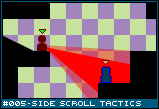|
Mechanic #005 - Side Scroll Tactics |

Category: Tactics | Posted: 05/13/07
A turn-based action game with a different familiar viewpoint gives a new perspective on the genre. |
Very simply put, this is a turn based tactics game (like Final Fantasy Tactics or Disgaea) set to a side view, platforming game perspective. Two great tastes that should taste great together. There are basically two aspects to a tactics game, that of movement and combat, which I will address here. The character abilities and balancing are largely secondary to the mechanical nature of just moving around and will not be the focus of the next few mechanics.
![[move.png]](set01/img/entry005-move.png)
Movement can be done quite simply. Just build a list of available squares one can move too - including basic terrain navigation like climbing ladders - and offer that list to the player to select. A flying creature would yield a similar movement pattern to a typical overhead tactics game, while a non-flying unit (seen here) would have a much more constrained course of action.
The reason why people don't tend to make tactical side scrolling games is due to the simple fact that movement in a side scrolling world almost always involves some sort of vertical movement, be it a grappling hook, jumping, or flying. Taking these kinds of actions into account with a traditional turn based format is non-obvious, but can be done. I intend to offer up a solution to a considerably more advanced movement system tomorrow.
Selecting the recipient of your actions is the second fundamental part of a tactics game. With a side scroller, you've got to take additional factors into account when deciding who you can hit. For instance, in an overhead view, either something is visible or it is not. This is usually a simplification of visibility, but it isn't distracting. Using a similar system for a side view game would be obnoxiously imprecise.
![[vision.png]](set01/img/entry005-vision.png)
Instead, I offer up a cone of vision method for selecting a unit to attack. Basically, from your character extends a cone and anything that falls within that zone can be selected. Distance is measured from the center of the attacker to the center of the defender. There is a line of sight rule going on (not unlike Commandos), where landscape may obscure some or all of another unit. In this case, how much of that unit is in the line of sight will be factored in to the missing equation.
One possibility is to allow a bullet to potentially hit any target in the red zone. As the unit's accuracy grows, the cone narrows. In this case, the hit percentage for the target would be based on how much of the red zone he occupies.
![[attack-types.png]](set01/img/entry005-attack-types.png)
Not all weapons would use the same arc. For example, the second example above is a shotgun. It has two arcs. Everything within the solid red arc has a strong potential to be hit by the blast, while the second larger faded arc represents a zone where errant damage can be inflicted but is not as likely.
The sniper rifle offers a very thin possible zone of hit, used to indicate that it can only hit one target and that it has a high accuracy.
The third example is a bow. The entire possibile arc is shown. The arrow could potentially follow any arc within that red zone. It looks like there is a fifty percent change to hit the designated target. If the roof tiles extended further blocking the upper arc, it would greatly affect the potential arcs available to the arrow.
![[melee.png]](set01/img/entry005-melee.png)
Melee targets can be selected simply by picking an adjacent square or a much shorter available radius. In this example, the attack is quite broad, hitting not just in front but also the square above.
![[magic.png]](set01/img/entry005-magic.png)
Magic is likewise very simple. Extending from the attacker is a radius of potential targets. It is not affected by line of sight. Then you've got the magic spell, the target spot is where the white X is, which has an area of effect extending from the target spot. Anything in that area of effect will be hit.
I see this game being played with a mouse, where you simply hover your mouse over an enemy unit and the most appropriate vision cone is shown. However, it could also be done cone-dominant, where you manually aim the cone and potential targets that are hit will be selected.
In a platform setting, there is a lot of vertical movement. It could become somewhat stale without a mechanics to provide things like jumping or falling off a ledge. For instance, just a single unit could be used to guard a path. Without a more involved movement system, the sidescroll tactics idea would work best in an environment where most, if not all, units can fly (or swim, as the case may be).
|